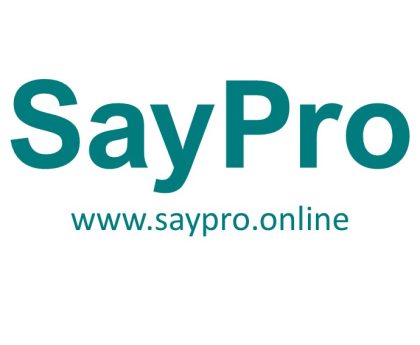SayPro Generate 100 cybersecurity best practices for web platforms such as SayPro from SayPro Monthly February SCMR-17 SayPro Monthly IT Services: Software development, cybersecurity, and IT support by SayPro Online Marketplace Office under SayPro Marketing Royalty
Section 1: Authentication & Access Control (1–20)
- Enforce Multi-Factor Authentication (MFA) for all admin and sensitive user logins.
- Use Role-Based Access Control (RBAC) to restrict permissions.
- Implement Session Expiration Policies to auto-logout idle sessions.
- Limit Login Attempts to prevent brute-force attacks.
- Use Strong Password Requirements (length, complexity, change cycle).
- Secure Password Storage using bcrypt, scrypt, or Argon2.
- Use OAuth 2.0 or OpenID Connect for third-party authentication.
- Log and Monitor All Login Attempts for abnormal behavior.
- Set Up Administrative Access Alerts for suspicious login behavior.
- Disable Legacy or Inactive Accounts regularly.
- Implement IP Whitelisting for admin or internal dashboards.
- Enforce Device Authorization for Critical Access.
- Prohibit Shared User Credentials.
- Use Unique API Keys per Integration.
- Apply Just-in-Time Access Controls for temporary privilege escalation.
- Enable Captcha on Login Pages.
- Encrypt Authentication Tokens both at rest and in transit.
- Use Session Tokens with Expiry and Rotation.
- Deploy Biometric Authentication Options (e.g., fingerprint for mobile apps).
- Conduct Regular Access Audits and Reviews.
🧱 Section 2: Infrastructure Security (21–40)
- Use a Web Application Firewall (WAF) to protect against common attacks.
- Patch Servers Regularly (OS, libraries, runtimes).
- Use Container Security Tools (like Aqua, Prisma Cloud).
- Enforce TLS 1.2 or higher for all web communication.
- Disable Insecure Protocols (e.g., FTP, Telnet).
- Isolate Production, Staging, and Development Environments.
- Run Services with Least Privilege accounts.
- Enable Firewall Rules for Inbound/Outbound Traffic.
- Use Cloud Security Posture Management (CSPM) tools.
- Scan for Open Ports Regularly.
- Ensure Database Access is Internal-only.
- Use Bastion Hosts for SSH Access.
- Restrict Root Access and Use Sudo Logs.
- Disable Unused Services on Servers.
- Automate Infrastructure as Code (IaC) with Security Checks.
- Encrypt All Storage Disks (e.g., EBS, S3, Cloud SQL).
- Monitor CPU, Disk, and Network Usage for Anomalies.
- Enable Cloud Audit Logging and Monitoring.
- Apply Network Segmentation for Microservices.
- Use Secrets Management Systems (Vault, AWS Secrets Manager).
🧪 Section 3: Application Security (41–60)
- Conduct Static Code Analysis (SAST) pre-deployment.
- Implement Dynamic Application Testing (DAST) regularly.
- Sanitize All User Inputs to Prevent XSS/SQLi.
- Use Prepared Statements and ORM Libraries to avoid SQL injection.
- Validate All API Requests and Parameters.
- Use CSRF Tokens for Forms and Actions.
- Secure File Uploads with MIME Type & Extension Checks.
- Implement Rate Limiting and Throttling.
- Use Content Security Policy (CSP) Headers.
- Minimize Data Stored on Client Side (e.g., localStorage).
- Avoid Exposing Internal APIs to Public Network.
- Disable Directory Listing on Web Servers.
- Scan Third-party Libraries for Vulnerabilities (e.g., using Snyk, OWASP Dependency Check).
- Display Generic Error Messages to Users (log detailed info internally).
- Verify Integrity of Packages via Checksums.
- Use HTTPS Strict Transport Security (HSTS).
- Secure Admin Dashboards Behind VPN or 2FA.
- Obfuscate Sensitive Source Code on Frontend.
- Regularly Conduct Penetration Testing (manual & automated).
- Restrict Inline Scripts Using Nonce-based CSP Headers.
🔄 Section 4: Data Protection & Privacy (61–80)
- Encrypt Sensitive User Data at Rest (AES-256).
- Encrypt Data in Transit Using TLS/SSL.
- Apply Data Masking on Logs and Interfaces.
- Follow Data Retention and Disposal Policies.
- Log All Access to Sensitive Data.
- Ensure GDPR and POPIA Compliance.
- Anonymize or Pseudonymize Personal Data Where Possible.
- Secure API Endpoints with Authentication and Authorization.
- Limit Personal Data Exposure via APIs.
- Implement “Right to Be Forgotten” Workflow.
- Avoid Logging Passwords, Tokens, and Payment Details.
- Use Tokenization for Payment Data.
- Conduct Regular Data Flow Mapping.
- Set Up Secure Backups with Encryption.
- Test Backup Recovery and Integrity.
- Apply Minimum Necessary Data Practices.
- Enable DLP (Data Loss Prevention) Solutions.
- Redact Sensitive Info from Error Screenshots or PDFs.
- Monitor for Unauthorized Data Export Activities.
- Use Email Encryption for Sensitive Communication.
🛡️ Section 5: Monitoring, Auditing & Incident Response (81–100)
- Enable Real-time Threat Detection Tools (e.g., SIEMs).
- Maintain an Incident Response Plan (IRP).
- Log All System Events Centrally.
- Use Anomaly Detection Systems.
- Run Regular Vulnerability Scans (Nessus, Qualys, etc.).
- Use Audit Trails for Key Admin Activities.
- Create Honeytokens and Trap Accounts for intruder detection.
- Conduct Security Drills/Simulations quarterly.
- Define SLA for Security Incidents.
- Auto-alert on Suspicious Behavior (e.g., data export, access spike).
- Ensure Time-synchronized Logging (NTP configured).
- Limit Retention of Sensitive Logs (as per compliance).
- Rotate and Archive Logs Securely.
- Notify Relevant Stakeholders on Breach Events.
- Perform Root Cause Analysis Post-Incident.
- Verify Patch Effectiveness After Incident Resolution.
- Subscribe to Vulnerability Alerts and Security Feeds (CVE, NVD).
- Ensure Staff is Trained on Phishing and Social Engineering Attacks.
- Review Permissions and Logs During Offboarding of Employees.
- Update Security Policies Every 6–12 Months.
✅ Summary & Application to SayPro
All cybersecurity practices listed should be incorporated into:
- SayPro’s IT Policies & Admin Procedures
- Development Sprints (via Secure SDLC practices)
- DevOps & Monitoring (via SayPro Monthly DevOps Reports)
- SayPro’s Cybersecurity Risk Audit Checklist Template
- SayPro Staff Security Awareness Training



